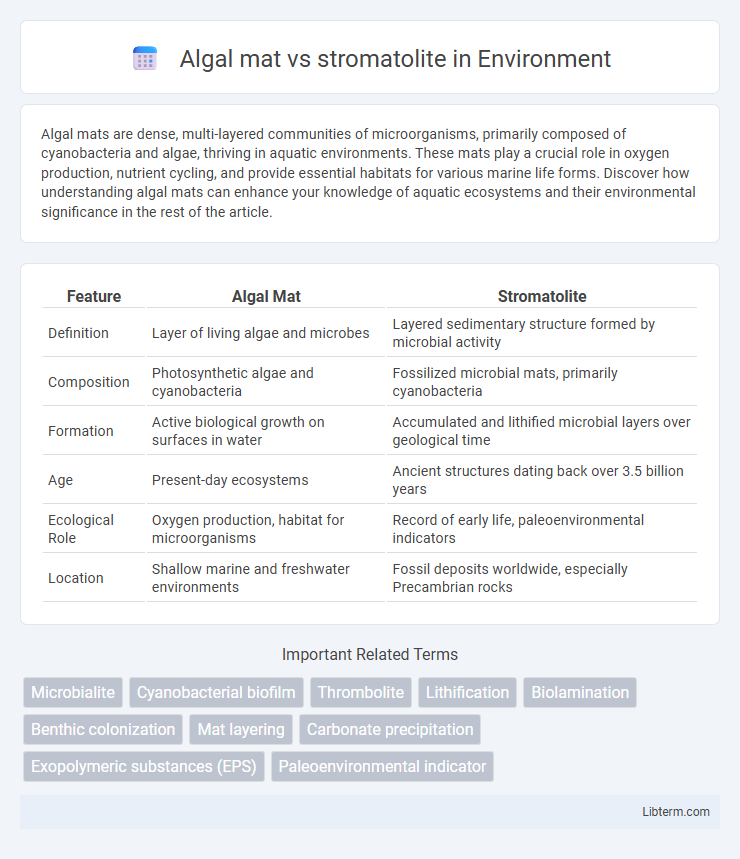Algal mats are dense, multi-layered communities of microorganisms, primarily composed of cyanobacteria and algae, thriving in aquatic environments. These mats play a crucial role in oxygen production, nutrient cycling, and provide essential habitats for various marine life forms. Discover how understanding algal mats can enhance your knowledge of aquatic ecosystems and their environmental significance in the rest of the article.
Table of Comparison
| Feature | Algal Mat | Stromatolite |
|---|---|---|
| Definition | Layer of living algae and microbes | Layered sedimentary structure formed by microbial activity |
| Composition | Photosynthetic algae and cyanobacteria | Fossilized microbial mats, primarily cyanobacteria |
| Formation | Active biological growth on surfaces in water | Accumulated and lithified microbial layers over geological time |
| Age | Present-day ecosystems | Ancient structures dating back over 3.5 billion years |
| Ecological Role | Oxygen production, habitat for microorganisms | Record of early life, paleoenvironmental indicators |
| Location | Shallow marine and freshwater environments | Fossil deposits worldwide, especially Precambrian rocks |
Introduction to Algal Mats and Stromatolites
Algal mats are multi-layered sheets of microorganisms, primarily cyanobacteria, that form in aquatic environments through photosynthesis, creating biofilms on surfaces. Stromatolites are fossilized structures formed by the lithification of algal mats, representing some of the oldest evidence of life on Earth dating back over 3.5 billion years. Both algal mats and stromatolites play a critical role in understanding early microbial ecosystems and the evolution of Earth's biosphere.
Defining Algal Mats
Algal mats are layered biofilms formed by the growth of cyanobacteria and other photosynthetic microorganisms, creating dense microbial communities on aquatic surfaces. These mats are characterized by their ability to trap and bind sediment, facilitating nutrient cycling and providing habitats for diverse organisms. Unlike stromatolites, which are lithified structures resulting from mineral precipitation within algal mats, algal mats remain primarily organic and flexible.
What Are Stromatolites?
Stromatolites are layered sedimentary formations created by the growth and metabolic activities of microbial mats, primarily cyanobacteria. These structures trap and bind sedimentary grains, forming distinct laminae that fossilize over geological time. Unlike simple algal mats, stromatolites exhibit complex, three-dimensional morphologies resulting from microbial accretion and sediment interaction.
Formation Processes: Algal Mats vs Stromatolites
Algal mats form through the dense layering of cyanobacteria and other microorganisms that trap sediment and organic matter in aquatic environments. Stromatolites develop over time as these microbial mats precipitate calcium carbonate, creating laminated, fossilized structures. The key difference lies in stromatolites' mineralization process, which leads to durable, layered formations, unlike the softer, non-lithified algal mats.
Structural Differences Between Algal Mats and Stromatolites
Algal mats consist primarily of layered colonies of microorganisms like cyanobacteria, forming soft, often homogeneous biofilms without significant mineral deposition. Stromatolites exhibit laminated, lithified structures created through the trapping, binding, and mineral precipitation by microbial communities, resulting in rigid, rock-like formations. The key structural difference lies in stromatolites' pronounced mineralized laminae compared to the more flexible, organic-rich layers of algal mats.
Ecological Roles and Habitats
Algal mats are dense, multi-layered sheets of cyanobacteria and other microorganisms thriving in diverse aquatic environments such as tidal flats, freshwater lakes, and hot springs, where they play crucial roles in primary production, oxygen generation, and nutrient cycling. Stromatolites, formed when algal mats trap and bind sediment layers over time, predominantly inhabit hypersaline lagoons and shallow marine waters, offering vital insights into early Earth ecosystems and acting as bioindicators of environmental stability. Both structures significantly contribute to sediment stabilization and carbon sequestration, supporting microbial biodiversity and sustaining food webs in their respective habitats.
Geological Significance Through Time
Algal mats represent modern microbial communities that actively trap and bind sediment, serving as analogs to ancient stromatolites. Stromatolites, as layered sedimentary formations produced by cyanobacteria, provide critical geological evidence of early life dating back over 3.5 billion years. Their presence in the fossil record marks significant milestones in Earth's biogeochemical cycles and oxygenation during the Precambrian era.
Fossil Records: Evidence and Interpretation
Algal mats are layered microbial communities primarily composed of cyanobacteria, which play a critical role in the formation of stromatolites--laminated sedimentary structures preserved as some of the oldest fossils dating back over 3.5 billion years. Stromatolites provide essential evidence of early life on Earth, captured through their distinctive morphological and geochemical signatures found in the fossil record. Analyzing these layered structures helps paleobiologists interpret ancient microbial ecosystems and understand early biogeochemical cycles.
Modern Examples and Distribution
Modern algal mats are widespread in hypersaline and intertidal environments, notably found in Shark Bay, Australia, where cyanobacteria form thick, cohesive layers promoting microbial diversity. Stromatolites, constructed by microbial communities including cyanobacteria, occur in fewer locations such as the Bahamas' Exuma Cays and Yellowstone National Park's hot springs, functioning as living fossils that showcase sediment trapping and binding processes. The distribution of algal mats and stromatolites highlights their ecological roles in nutrient cycling within extreme environments and their significance in studying early life on Earth.
Key Differences Summarized: Algal Mats vs Stromatolites
Algal mats are layered microbial communities primarily composed of cyanobacteria and other microorganisms, forming soft, flexible biofilms on aquatic surfaces. Stromatolites are fossilized or living accretionary structures created when algal mats trap and bind sediment, resulting in rigid, laminated carbonate formations. The key difference lies in algal mats being primarily biological and dynamic, while stromatolites are mineralized structures representing the geological record of ancient microbial life.
Algal mat Infographic

 libterm.com
libterm.com